Instruments
By David Gibbons, 2 March 2022
Gongs,Bowls,Etc.
All of my gongs, save one, are bronze 'Chau' gongs made in Wuhan, China by various makers. (Some were imported by the good folks at 'Gongs Unlimited', and others by 'The Gong Shop') Chau gongs have a turned-back rim, and the front is not quite flat. The shiny area you see in the images is where metal has been lathed away. The back face typically has metal removed in the same area as the front in traditional Chau gongs. The dark areas show the bronze finish as it left from the furnace. The removal of metal by lathing has one crucial effect - the metal is thus thinner in the shiny areas, changing how the gong vibrates. This is typically not mentioned in discussions of these instruments.
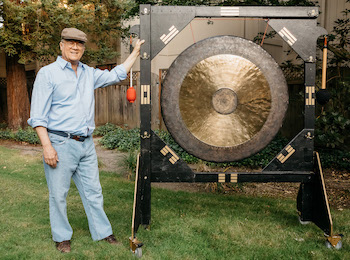
Here is the 111cm diameter Chau gong I call "The Great Prince". It is made of 65 pounds of bronze, and has a deep and enveloping voice. It was crafted by the Wuhan ZingSir Musical Instrument Co. in Wuhan, China. After a bit of work smoothing out some literal rough edges and building a stand, I am very happy with this instrument.
Play the Great Prince with a heavy, soft beaterA side note on the recordings: Some of these instruments go very low in frequency. I also let the sounds die away to near silence, so a set of good headphones or earphones may help you to hear everything in these sound clips.
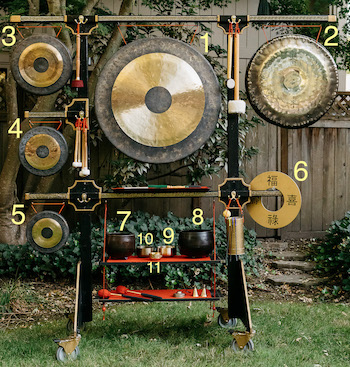
The rest of the gongs all live together on their own gong stand. I built this stand to also hold other smaller instruments. The gongs on this stand save one are Chau gongs made in Wuhan, China by various makers. They range in diameter from 76cm down to 25cm. (See items #1 and #3 through #5 in this image)
The one different gong(#2)is a Paiste gong with an interesting origin story. It was made by Paiste for the Ludwig drum company in the 1960's. Ludwig combined it with a stand and offered it to rock band drummers of the day. I found it via CraigsList, and had to do a lot of work polishing off rust (from the stand) and corrosion (from the gong itself). It looks good, and still has an interesting voice. It is quite different from the Chau gongs in its material (a 'nickel-silver' alloy called Alpaca) and thickness, and it also has a slightly different profile on its front face.
Item #6 is a steel disk which I discovered had an interesting tone with good sustain when I dropped it onto a concrete floor one day. (There's more to that story; ask me sometime) I decorated it to look somewhat like a Chinese coin, with the characters for 'Fu'(Blessings), 'Lu' (Prosperity), 'Shou' (Longevity), and 'Xi' (Happiness).
Items #7 through #11 are bowl bells called 'Rin' in Japan. These 5 bowls all came from Japan, with #7 and #8 being old pieces hand-hammered from bronze. I actually purchased #9, #10, and #11 in Japan during trips there. They appear to be turned from brass or some other similar alloy. Due to their construction, #7 and #8 are quite delicate, and must only be struck on the outside side of the top edge of the rim. These bowls can be made to 'sing', but that is not their strong point.
Play Gong #1 with a heavy beaterPlay Gong #2 with a felt-faced rubber mallet
Play Gongs #3, #4, and #5 with a light mallet
Play Bowl #7 with a felt-faced wooden striker
Play Bowl #8 with a felt-faced wooden striker
Play Bowl #9 with a felt-faced wooden striker
Play Bowl #10 with a felt-faced wooden striker
Play Bowl #11 with a felt-faced wooden striker
Play all the bowls in sequence with a felt-faced wooden striker
Play the Coin with a felt-faced wooden striker
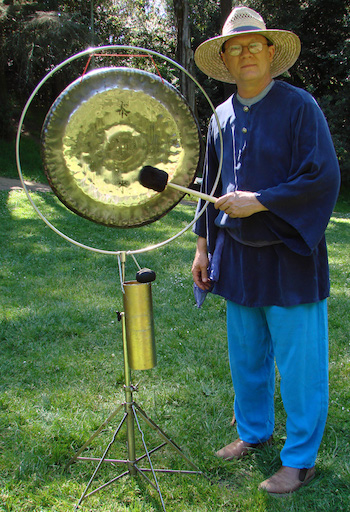
Here is the Paiste on its original stand, as it came from Ludwig all those years ago. I have made a more convenient stand base for it when I am taking the Paiste out by itself. Otherwise, it has a home on the main stand with all of the other smaller gongs.
Chimes
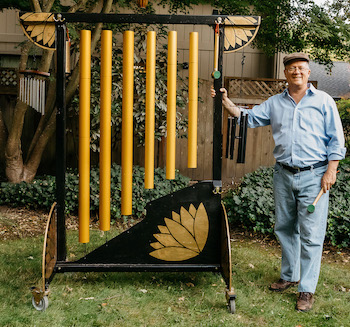
I made this set of large chimes and call them 'free chimes', as they are suspended and played in a manner different from orchestral chimes (AKA tubular bells). These chimes are supported such that they have a very long sustain, and also such that one gets different sounds from them depending where they are struck. (AND what you hit them with) These heavy aluminum chimes are tuned to a particular pentatonic scale called the 'Pythagorean' scale, so that all 6 notes sound good together.
Note the set of smaller black wind chimes on the right side of the stand. (Music of the Spheres makes very good wind chimes.)
Play the chimes in sequence with a felt-faced rubber malletPlay a familiar church bell tune on the chimes with a felt-faced rubber mallet
Drum
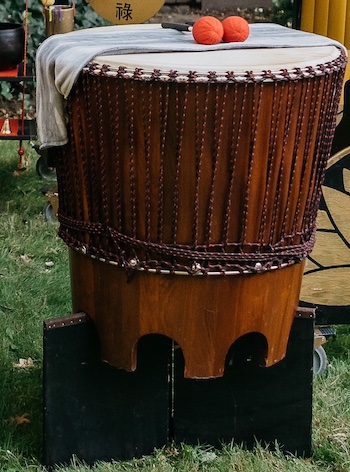
This wooden-bodied drum, imported by Mid-East Manufacturing from Pakistan, has a deep voice that compliments the other instruments. This big drum does not like cool damp conditions, so it doesn't often come outside at night.
Play the big drum gently with a heavy soft malletHandpan
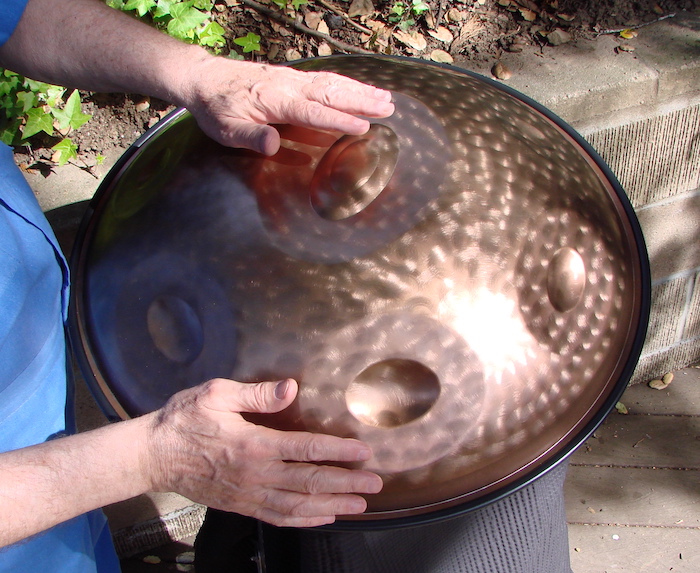
This instrument is one of the 'tuned' instruments in the collection. It is tuned for a minor key, with the lowest note being a D. It was skillfully made by the 'Saraz' folks in Asheville, North Carolina.
Play the handpan with gloved hands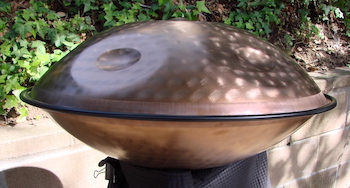
This handpan also has a mellow smile, as you can see in the above image
Native American Style Flute
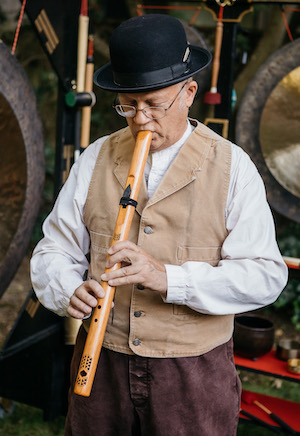
This 'High Spirits' brand flute is one of the other 'tuned' instruments in the collection. It is tuned in the key of G Minor. I have several other flutes of this type, of different keys and sizes.It is fun to play the flutes next to the larger gongs and the handpan, which sometimes gently sing back to the flutes.
Listen to a High Spirits Native American Style Contra Bass fluteI have put up these sound files of each of the main instruments so you can get a feel for the individual sounds of a Tranquil Sound Gardens presentation. Blending the sounds, and exploring the sound possibilities of each instrument is something I work hard to do. The larger gongs and the chimes in particular have very wide ranges of expression. These sound files are not of the highest quality, but I hope they give you at least an idea of each instrument's character.
Names of Instruments
What started out as a joke has become a bit of a tradition for me. Early on, I told folks that the 30" Chau gong was called 'Bambi', because I hit it with a 'Bam!'. The big drum is called 'Thumpette'. (I had a much bigger drum I called 'Thumper', but in an attack of commonsense I swapped it in 2017 for this somewhat smaller drum, which naturally got named Thumpette.) This set me on the course of using names from the famous Disney film 'Bambi'.
The chime set, with its lotus decorations became 'Flower'. The Paiste gong, badly pockmarked with corrosion when we got it, had to be named 'Freckles', even though there was no such character in the film. Later, the massive 44" Chau gong arrived and was promptly christened 'The Great Prince', which was Bambi's father's name. A few years before Disney released 'Bambi", they released 'The Tortoise and the Hare'. Toby the Tortoise is now the handpan's name, because playing him slow and steady really cultivates tranquillity.
As you can tell from the above, I take myself and these instruments completely seriously.(grin)
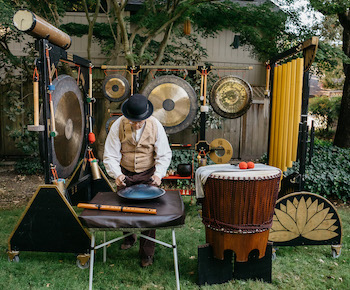
Updated 2 march 2022
Contents copyright 2022 by David C. Gibbons
